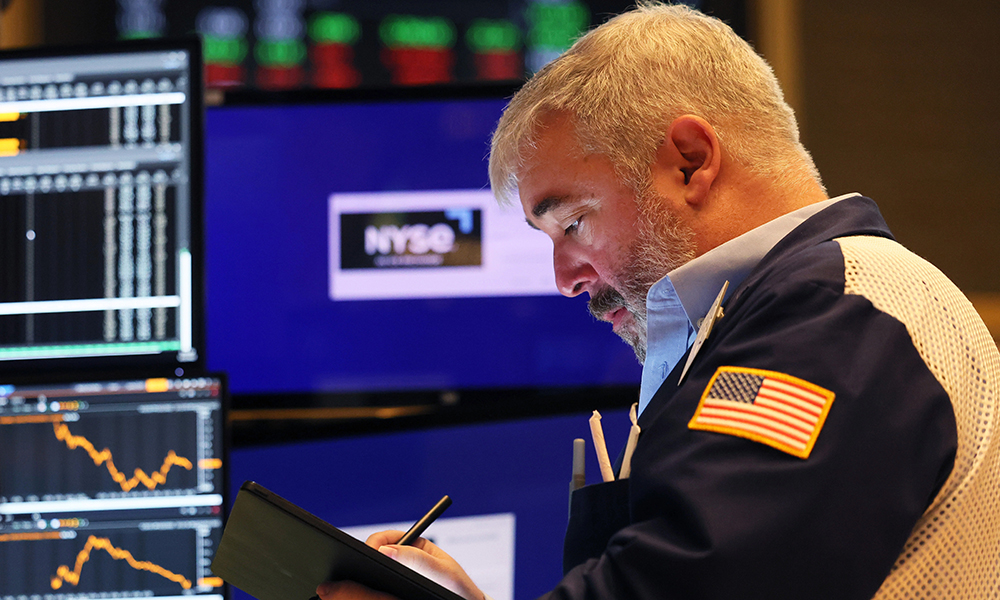
華爾街最著名的賣空人士之一認(rèn)為,在重新開始拋售之前,美國股市目前的漲勢將會延續(xù)。
以邁克爾·威爾遜為首的摩根士丹利(Morgan Stanley)策略師表示,標(biāo)準(zhǔn)普爾500指數(shù)(S&P 500 Index)可能會繼續(xù)攀升5%至7%,然后再恢復(fù)跌勢。
他們在一份報告中寫道:“我們認(rèn)為美國股市可能進一步反彈。”債券收益率和油價雙雙下跌,緩解了人們對通脹失控的擔(dān)憂,使得基準(zhǔn)股指結(jié)束了連續(xù)三周的跌勢。
由于擔(dān)心美聯(lián)儲(Federal Reserve)的強硬立場和通脹飆升可能讓美國經(jīng)濟陷入衰退,美國股市今年一直處于動蕩之中。標(biāo)準(zhǔn)普爾500指數(shù)在從1月的峰值下跌20%后進入熊市,并可能迎來自1970年以來最糟糕的上半年。
威爾遜正確預(yù)測了今年的拋售,他表示,整個跌幅的38%至50%的回調(diào)“很自然,也不會與之前的熊市反彈不一致”。他說,這將使標(biāo)準(zhǔn)普爾500指數(shù)最多升至4200點,較6月24日收盤上漲約5%至7%,利率敏感型股票將推動股市反彈。
但威爾遜警告稱,由于擔(dān)心經(jīng)濟放緩導(dǎo)致油價和收益率下跌,而不是通脹見頂,股市最終將繼續(xù)下跌。
“熊市可能還沒有終結(jié),盡管未來幾周可能會有熊市終結(jié)的感覺,因為市場將降息視為美聯(lián)儲能夠?qū)崿F(xiàn)軟著陸并防止對盈利預(yù)測進行大幅修正的跡象。”該策略師說道。
在要求經(jīng)濟軟著陸的基本情況下,威爾遜認(rèn)為標(biāo)準(zhǔn)普爾500指數(shù)將在3400點至3500點之間觸底,較最新收盤點位低13%。他說,經(jīng)濟衰退將讓該指數(shù)下跌23%以上,至3000點左右。(財富中文網(wǎng))
譯者:中慧言-王芳
華爾街最著名的賣空人士之一認(rèn)為,在重新開始拋售之前,美國股市目前的漲勢將會延續(xù)。
以邁克爾·威爾遜為首的摩根士丹利(Morgan Stanley)策略師表示,標(biāo)準(zhǔn)普爾500指數(shù)(S&P 500 Index)可能會繼續(xù)攀升5%至7%,然后再恢復(fù)跌勢。
他們在一份報告中寫道:“我們認(rèn)為美國股市可能進一步反彈。”債券收益率和油價雙雙下跌,緩解了人們對通脹失控的擔(dān)憂,使得基準(zhǔn)股指結(jié)束了連續(xù)三周的跌勢。
由于擔(dān)心美聯(lián)儲(Federal Reserve)的強硬立場和通脹飆升可能讓美國經(jīng)濟陷入衰退,美國股市今年一直處于動蕩之中。標(biāo)準(zhǔn)普爾500指數(shù)在從1月的峰值下跌20%后進入熊市,并可能迎來自1970年以來最糟糕的上半年。
威爾遜正確預(yù)測了今年的拋售,他表示,整個跌幅的38%至50%的回調(diào)“很自然,也不會與之前的熊市反彈不一致”。他說,這將使標(biāo)準(zhǔn)普爾500指數(shù)最多升至4200點,較6月24日收盤上漲約5%至7%,利率敏感型股票將推動股市反彈。
但威爾遜警告稱,由于擔(dān)心經(jīng)濟放緩導(dǎo)致油價和收益率下跌,而不是通脹見頂,股市最終將繼續(xù)下跌。
“熊市可能還沒有終結(jié),盡管未來幾周可能會有熊市終結(jié)的感覺,因為市場將降息視為美聯(lián)儲能夠?qū)崿F(xiàn)軟著陸并防止對盈利預(yù)測進行大幅修正的跡象。”該策略師說道。
在要求經(jīng)濟軟著陸的基本情況下,威爾遜認(rèn)為標(biāo)準(zhǔn)普爾500指數(shù)將在3400點至3500點之間觸底,較最新收盤點位低13%。他說,經(jīng)濟衰退將讓該指數(shù)下跌23%以上,至3000點左右。(財富中文網(wǎng))
譯者:中慧言-王芳
One of Wall Street’s most prominent bears sees the current rally in US stocks extending—prior to the selloff recommencing.
Morgan Stanley strategists led by Michael Wilson say the S&P 500 Index may climb another 5% to 7%, before resuming losses.
“We think US equity markets can rally further,” they wrote in a note, with a decline in both bond yields and oil prices having eased some worries around runaway inflation and helping the benchmark snap a three-week losing streak.
US stocks have been roiled this year by concerns that a combination of a hawkish Federal Reserve and surging inflation could tip the economy into a recession. The S&P 500 is in a bear market after falling 20% from its January peak and is on course for its worst first half since 1970.
Wilson, who correctly predicted this year’s selloff, said a retracement of 38% to 50% of the entire decline “would not be unnatural or out of line with prior bear market rallies.” That would lift the S&P 500 to as much as 4,200, giving the index about 5% to 7% upside from June 24’s close, with interest-rate sensitive stocks driving the rebound, he said.
But with fears of an economic slowdown driving the drop in oil and yields rather than a peak in inflation, stock markets are ultimately in for more declines, Wilson warned.
“The bear market is likely not over although it may feel like it over the next few weeks as markets take the lower rates as a sign the Fed can orchestrate a soft landing and prevent a meaningful revision to earnings forecasts,” the strategist said.
In his base case, which calls for a soft economic landing, Wilson sees the S&P 500 bottoming between 3,400 and 3,500 index points—as much as 13% below its latest close. And a recession would send the index more than 23% lower to about 3,000, he said.






